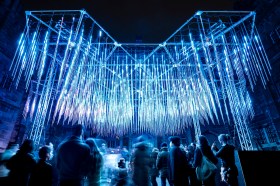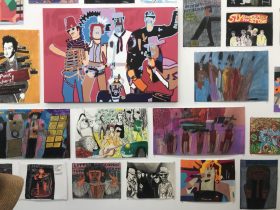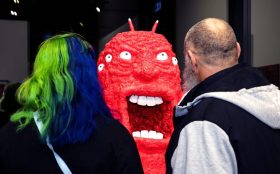Group shows often trade breadth for depth and always risk conceptual dissimilitude. Not so here. What is striking about the show is that each work is immediately and readily accessible but below the easy visual hand shake you’ll find strong inner forces at play – some grinding, some introspective, others humorous-serious.
In the front exhibition room, artist Rosie Royston’s ‘Collective’ wall text looks bright and cheery next to Susie Leahy Raleigh’s vivid green enamel ‘Simulated silence’. Spelling out the name of the show, it reads at first glance like an exhibition banner. Look closer though and the text is formed by imprisoning memorabilia – toys, dolls, trinkets – in restraining wire mesh.
On the floor between these works, Rob Ball’s ‘Slip Knot’ offers a similar duality of encounter. The work is a self-supporting sculpture of strongly coloured, overscale bent knitting needles held together by two dark, encircling needles (referencing the mythological Ourobouros serpent, which bites its own tale). Ball has a background in film but ‘Slip Knot’ reveals a knack for spatial manipulation not readily achievable in that medium. This seems to be a work that has emerged into colour from a darker place.
In the same room, set discretely away, Rebecca Monaghan presents a paired sculpture of two white, matt enamel forms constructed as spirals of what looks like paper but which turns out to be pressed aluminium (Ego and Shadow). They incline towards each other in a self-absorbed admiration, almost oblivious to their surroundings. The pairing and the way the forms are so engrossed, one in the other, draws on Jung and seems to echo Platonic notions of the human soul divided, longings for unification – this work should be read as one form composed of two elements.
Looking at artist Klara’s ‘Untitled’ passing into the next room, it seems somewhat ironic that the much-neglected Keith Haring mural is just across the road from the gallery. Klara seems to be channelling Haring and the artist speaks of being “imprinted” by the influences that shape the work, a notion perhaps drawn from classical behavioural theory or perhaps even the new science of epigenetics.
In the back space, performer Teresa Blake’s interactive installation ‘Please Sit Down’ has been the popular star of the show. This work’s title is an invitation – you need to try this one out, not just look. When you mount the bright yellow dais, operate the foot treadle and bang your head against the suspended sheet metal, your chair suddenly becomes a speaker playing a mostly percussive score. The effect can be hilarious. A good thing too, because the other works in this room are not so light hearted.
Lilly Waters and Candice Hopkins both explore gender identity with richly evocative, sometimes sensuously beautiful, imagery while Nick Heysbergh and Nadine Mannering explore resonances around articulating self-identities. For Heysbergh that means negotiating the interpersonal power terrains of gender-concordant relationships; to Mannering it means iterative self-representations.
Presenting what seems to be the only political work in the show, Gary Anderson sets critical theorist Theodor Adorno against right-wing philosopher Martin Heidegger, using two photographs by August Sander, arguably Germany’s greatest photographer of the 20th century. Sander’s politically active son, Eric (the subject of this work) was imprisoned and died under the Nazis. Adorno’s paratactic paring technique is used to impose structure on a Heideggerian unveiling – here emblemised by cutting thin strips off the image – to memorialise a tragedy and perhaps suggest who won the argument.
To move to the upstairs rooms you need to pass by Tessa Montcrieff’s set of emblematic drawings on plywood rondelles; these works look a little like modern-day theosophical icons full of energy and detail. Further up the stairs you’ll pass Susan McMinn’s slightly crushed-looking ink work on paper.
Capping off the show are two very successful video installations. Michael Joseph frames up web imagery into neat boxes, the method itself a meta-commentary on his concern with web-based media disconnecting us from our own subjectivity and authentic identity (Adorno saw it coming). Georgina Lee’s intricate installation ‘to Whatever End’ is like a paean to the day dream. She has recreated a corner-office module complete with all the minutia of corporate bureau life: Post-It notes, stamps, files, photocopy paper. Two partition walls form a back drop. Waving rhythmicall – as if there were a summer breeze – a field of animated, purple, cosmos-like flowers is projected onto the partitions and plays concurrently on a computer monitor. On the wall nearby, three pie chart clocks mark out the progression of time in all its banality as life ebbs on.
Somewhere between a dream, a statement and a memory ‘The Collective’ exactly hits its mark.
The Collective
Off the Kerb, 66B Johnston St, Collingwood
December 9–23, 2011
For more information, visit offthekerb.com.au





